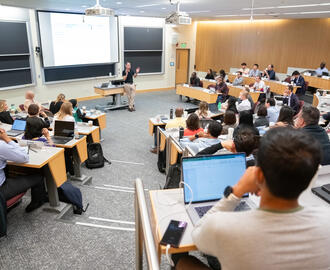When the first MIT Executive MBA cohort arrived in October 2010, they were greeted by a team of administrators and faculty determined to offer something fundamentally different in the world of executive education. Among them were Johanna Hising DiFabio, who had joined MIT Sloan just two months earlier to help launch the program, and Professor Nelson Repenning, an expert in system dynamics and organizational change, who’d become one of the program’s key architects.
DiFabio, now Assistant Dean of the MIT Executive Degree Programs, was tasked with shaping not only the operations but also the community and culture of a program that had long been discussed but never realized, until Dean David Schmittlein gave it the green light. Repenning, former Faculty Director of the MIT EMBA and current Faculty Director of the MIT Leadership Center, helped define the program’s intellectual foundations. He helped create the Organizations Lab (O-Lab), a course designed specifically for executives to diagnose and improve real-world systems within their own organizations.
What were the origins of the MIT Executive MBA program?
Johanna Hising DiFabio, Assistant Dean, Executive Degree Programs
DiFabio: MIT Sloan had tried three times before to launch an Executive MBA, and each time it didn’t get off the ground. There was a lot of concern that it would cannibalize the Sloan Fellows Program (now Sloan Fellows MBA). Faculty were also worried we wouldn't get MIT-caliber students. But Dean Schmittlein really believed in it. He said we needed to build out a more complete portfolio, so we launched programs like the Master of Finance, the Master of Business Analytics, and then the Executive MBA.
In spring 2010, we invited people from our executive education database to attend a weekend pilot. It was a half-day Friday and Saturday. We charged around $100 and offered a taste of what the program might be. The response was strong. People wanted it. That summer, I was hired to help build the program. We launched the first cohort in October with 62 students.
What was your vision for the kind of experience you wanted EMBA students to have?
Repenning: We weren’t trying to build a program that was just a break from work. We wanted something that had the same level of rigor you'd expect from MIT. We designed it to be academically challenging but also directly relevant so people leading big pieces of their organizations could immediately apply what they were learning. And that’s what allowed us to create a real-time learning environment, one where feedback loops between class and the workplace were constant.
DiFabio: The EMBA is the program that delivers on MIT Sloan’s mission the quickest. We wanted a program where people could come in on Friday and Saturday, and by Monday, they’re already applying the concepts at work. That type of immediacy is powerful. And because these students are coming in with a lot of experience and responsibility, the classroom becomes an incredible space for learning, not just from faculty, but from one another.
Were there any surprises in the first few years of the program?
Nelson P. Repenning, School of Management Distinguished Professor of System Dynamics and Organization Studies
Repenning: One big surprise was just how fast the students wanted to go deeper. We had initially designed the curriculum assuming we’d need to ease people into the material, but we quickly learned we had underestimated them. They were hungry for challenge and really motivated to get their hands dirty. That raised the bar for everyone, students and faculty alike.
Can you talk about the evolution of the program’s identity and reputation over time?
DiFabio: In the beginning, we were a program trying to prove ourselves. I remember wondering, “Will people even apply?” Now we hear from applicants who say, “My boss went through it,” or “My mentor did this program and it changed their life.” That’s the shift. It’s become a degree that people respect, and a lot of that credit goes to our alumni. They’re the ones showing what an MIT EMBA looks like in the world.
What role has diversity of industries, backgrounds, perspectives played in shaping the MIT EMBA experience?
DiFabio: We build each class intentionally to bring together people from across industries—healthcare, energy, tech, finance, government, the military, entrepreneurship, etc. Those different backgrounds make the classroom conversation deeper and the learning more dynamic. When you’re sitting next to someone from a completely different world, you’re going to be challenged in the best possible way.
Repenning: One of the things we talk about in systems thinking is that you want diversity of mental models. That’s where real insight comes from. If everyone in the room thinks the same way, you’re not going to get much friction. But if you bring in people from different contexts and disciplines, they challenge each other’s assumptions. And that productive friction? That’s gold. That’s where the good stuff happens.
How has the faculty adapted to this kind of executive audience?
Repenning: Teaching in the EMBA is different from anything else we do. You’re not just giving a lecture, you’re curating a conversation. You must be open to learning from the students and be willing to adjust in real time. It’s more of a dialogue, and that keeps us sharper, too. I tell the faculty, “These students are going to push you, and that’s a good thing.”
What do you hope the next decade looks like for the MIT EMBA?
Repenning: The problems that our students face in the world aren’t getting simpler. I’d love to see us keep evolving, keep pushing on how we teach implementation, how we teach systems thinking. The goal is to make sure we’re still helping them go out and solve meaningful problems. We’ve got to keep innovating.
DiFabio: I think a lot about depth. Not necessarily getting bigger, but how can we go deeper? Can we strengthen alumni engagement? Can we create new labs that allow students to explore different challenges? I want us to keep asking: How do we help these incredible leaders amplify their impact? Because if we’re doing that, we’re doing our job.
Related Posts



